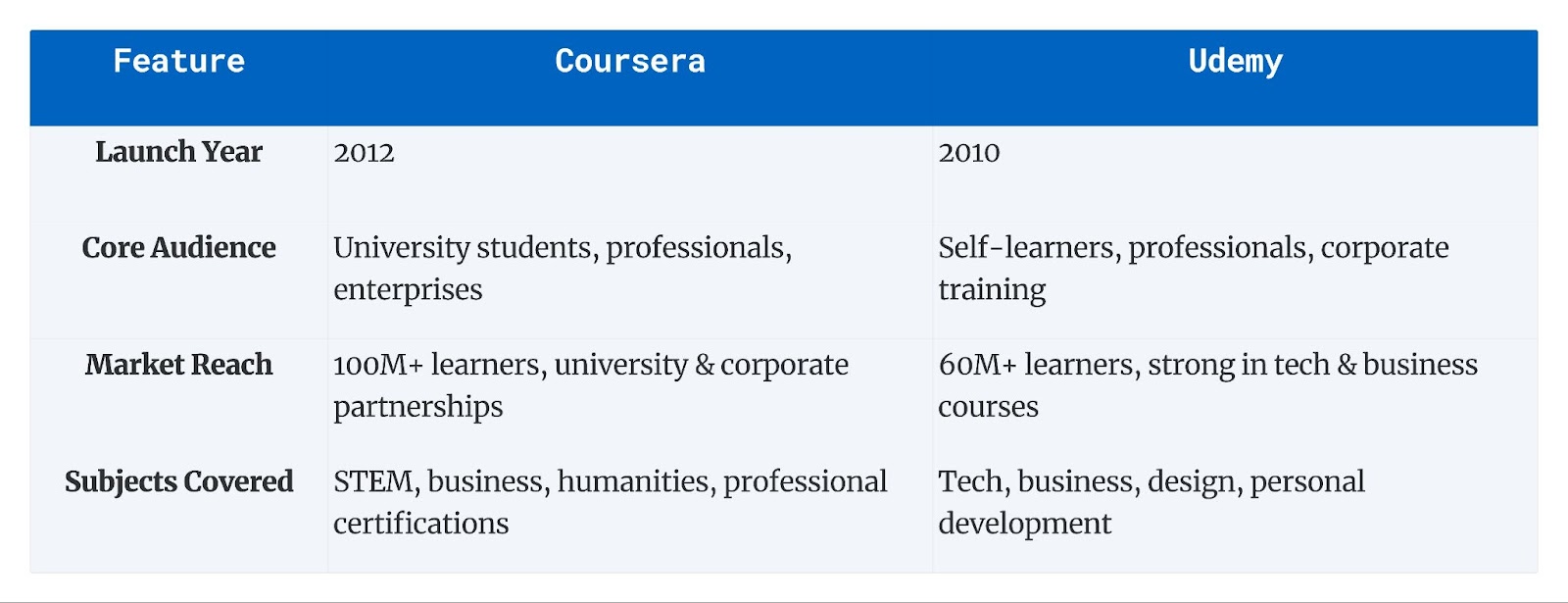Blog Technology industry trends
How to Build a Profitable eLearning Marketplace Like Udemy or Coursera

eLearning has witnessed exponential growth over the past few years due to changes in educational dynamics, demand for flexible learning, and less expensive courses. With this growing demand, many investors are also looking forward to investing in the e-learning platform due to the high revenue in this space.
Udemy and Coursera are the top players in the e-learning market and many entrepreneurs want to build platforms like them. However, what are the right approaches to building an excellent learning marketplace like Udemy or Coursera? So this blog is all about the insights you need to know to build a profitable eLearning marketplace.
What is an eLearning Platform?
An eLearning platform is designed to be a virtual space where learners can access educational resources. These platforms offer a variety of educational content, such as courses, study material, educational videos, blogs, webinars, Q&A, and more. With these platforms, anyone can pursue their education, train themselves, and get the professional certifications to boost their careers. Moreover, these platforms provide flexibility and efficient solutions for those who want to learn remotely. As per the latest research from Grand View Research, the eLearning market will reach 842 billion dollars by 2030. Hence, building an eLearning marketplace can be an excellent decision for the businesses.
Types of eLearning Platforms
As we have mentioned earlier, eLearning platforms have evolved over the last few years, and there are now multiple types of eLearning platforms in 2025. So here is the list of the types of eLearning platforms that you should know before building one:
1. Asynchronous Learning Platform
These e-Learning software development are designed for self-paced learning on which learners get the pre-recorded study materials. On asynchronous online learning, learners can access the courses anytime and learn at their convenience.
2. Synchronous Learning Platform
On these platforms, courses are not pre-cord instead students get real-time learning through live sessions from the educators. With synchronous online learning, students can get personalized learning and interactive sessions.
3. Blended learning platform
This platform is a combination of asynchronous and synchronous where learners get the study material and the live sessions from the educators. It is beneficial in getting personalized learning with the flexible education system.
4. Computer Managed Learning (CML)
Computer-managed learning platforms are integrated with AI to manage the educational processes including learner performance, personalized learning as per the learners' progress, etc. These platforms are designed to provide a more engaging environment to students so that they can access relevant courses.
5. Computer-Assisted Instruction (CAI)
This eLearning platform combines the multimedia capabilities to improve the engagement through interactive videos, graphics and images. Computer-Assisted Instruction (CAI) is also designed to increase the engagement of the students.
6. Virtual Learning Environments (VLEs)
These eLearning platforms are integrated with other tools like assessment management, course content tracking, performance monitoring, collaboration features, and many more. Virtual Learning Environments (VLEs) work as an advanced eLearning system with better progress tracking and education systems.
7. Learning Management Systems (LMS)
LMS Platforms provide, manage, and monitor online courses. These platforms allow the educator to enroll students into the course, monitor the progress of the learners, and conduct frequent assessments.
8. Interactive Learning Platform
These platforms are designed to encourage the learners to take interactive quizzes, puzzles, and games to test the skills they learned from the courses.
9. Micro-Learning Platform
These platforms are designed to provide target-based learning where students get small targets to address their skills on specific topics.
10. Mobile Learning Platform
These platforms are designed to provide a mobile-first experience so that learners can access their course anytime and anywhere.
The Must-Have Features of the eLearning Platform.
To stay ahead of the higher competition in the eLearning industry, it is essential for the eLearning platform to have the following features:
-
Adaptive learning system with AI integration.
-
Gamification to improve learning and engagement of the students.
-
Better mobile version to improve accessibility.
-
Community platform support so that learners can interact with their fellow learners and talk about the topics they are learning.
-
Advanced analytics to provide brief information about the progress of the learners.
-
Valid certifications after completing the course so that learners can use those documents to display their skills in their portfolio.
-
Flexible pricing model with secured payment processing.
-
Multi-language support so that students can take the courses in the language they are comfortable with.
-
Ability to integrate other third-party tools to improve the platform's features and scalability requirements.
-
Highly secured services so that there can be no breaches of the learner's important data like their contact details, payment details, and course details.
How to Build an eLearning website like Udemy and Coursera?
Building an eLearning platform like Udemy and Courses requires multiple stages. These steps involve market research, development strategies, quality assurance, and monetization. Hence, you need to consider every single step to develop a better eLearning website:
1. Perform Market Research and Define a Niche
Start your planning for the eLearning platform with the following strategy:
-
Identify your Target Audience and the niche to find out the specific subjects or skill sets you want to offer in the course. It will help you understand the pain points, preferences, and requirements of your potential learners.
-
Perform a Competitor Analysis to identify the strengths and weaknesses of your competitors.
-
Identify the Unique Selling Proposition (UDP) of your platform that can make you better than other eLearning websites in the market.
The the below given table will also help you understand the approaches that Udeemy and Coursera took to establish tier platforms:

2. Define Features and Options
With the market research, you will get brief insights about the features your competitors are offering. Hence, collect the data on the features you want to offer, such as:
For Learners
-
Simple registration & login
-
Course filtering options
-
Learners' dashboard
-
Simplified payment portal
-
Live classes support
-
Course review system
-
Discussion forum
For Instructors
-
Instructors' dashboard
-
Course management system
-
Revenue and payout tracking
-
Live streaming support
-
Discounts and coupon tools
For Admins
-
Users management dashboard
-
Subscription management system
-
Real-time analytics support
-
Security system support
3. Choose the Right Framework
You can build the eLearning platform through different frameworks and techs as per your requirements. Here is the list of the technologies you can use:
For the User Interface (Front-end): you can use React.js/Next.js for the faster and scalable solution. In case you need an alternative UI framework then it is best to go for Vue.js/Angular.
For the Server-side (Backend): for developing real-time features go for the Node.js + Express but use Django/Python for building AI-driven platforms.
For the Database: You can use PostgreSQL/MySQL to manage the structured data, and MongoDB for better flexibility.
For Cloud Hosting: If you are looking to build a scalable infrastructure then go for AWS/Google Cloud/Azure. However these solutions can be expensive so you can also go for DigitalOcean/Linode for the budget friendly VPS.
Third-Party Integrations: Your platform must obtain Stripe/PayPal for payment gateway, Zoom API/WebRTC for live streaming, and TensorFlow/ OpenAI API for AI-powered features.
Coursera and Udemy have also used similar techs in their platforms, such as:
4. The Development Phase
For the development phase, you will need a team of developers and designers for the best possible results. The roadmap for the eLearning platform development must include:
For UI/UX Design: Use different platforms like Figma, Sketch, and Adobe XD etc., and make sure to prioritize the mobile-friendly design.
For MVP Development: Add essential features like course enrollment, payment system, learner login, instructor login, etc. You can also use the LMS systems to add more relevant features to the platform.
Consider Additional Features: Try to add additional features like game factions, course recommendations, and other community features.
Multiple Testings: Perform multiple testings and security checks, and launch it on the cloud hosting for beta testing. Once you are done with the beta tests, then make the platform live for users.
5. Launch Your Growth Strategies
Develop the marketing and growth strategies to compete with the big names of the eLearning industry. Your marketing strategy must include”:
-
SEO Optimization
-
Social Media Marketing
-
Freemium Model
-
Referral Program
-
Partnership with Influencers
6. Perform Continuous Improvements
After launching your eLearning platform, make sure you continuously monitor the performance and gather feedback from your customers. With feedback, build more strategies and brainstorm about the new features you can launch in the coming months.
Conclusion
So this was all about the complete roadmap you can use to build a profitable eLearning marketplace like Udemy or Coursera. We have included all the possible features you can include in the eLearning platform to stay competitive in the current market. Moreover, we recommend you invest in the custom e-learning Software Development services to get full control over the platform and scale it as per the requirement.



